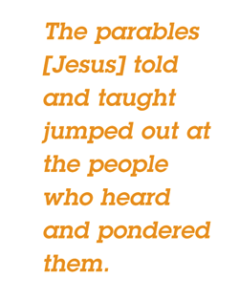You Give Them Something To Eat …
Making our lives a moral and spiritual lesson, a parable, for others to know and follow.

John A.H. Tomoso†
Why did Jesus teach in parables? Parables are simple stories used to illustrate a moral or spiritual lesson. In the Sacred (Hebrew and Christian) Scriptures, there are words full of imagery and analogy, storytelling and nuance. Jesus knew the Scriptures well and He was well-aware of how enriching the words, even in their unspoken intent, had great meaning for the people. Jesus was certainly well-versed in the rich tradition of scriptural (biblical) imagery and deep meaning of words that literally jumped out of the page and into the heart and soul. The parables told and taught jumped out at the people who heard and pondered them. The parables of Jesus acted as filters. Some people only heard simple stories while others got the deeper meaning. These parables became for many, portals to discipleship, belief in something not seen but tangible out of faith. They also served as somewhat clarion calls to truth, understanding and commitment. These parables continue to serve us well in the present age.

I recently had the opportunity to deliver a homily on the story of the Feeding of the Five Thousand in the Gospel of Matthew. This story of the feeding of many, out of what little there was, must have been deep in the memory of the disciples because all four evangelists record it in the Gospel they wrote. I think that one reason for this was that so many later theological themes about Jesus converged in the story as it was told and retold. The three synoptic Gospels (Matthew, Mark and Luke) are close in detail and the fourth Gospel, John, expands this story—an event of epic proportions—to make it the basis for many of the theological themes that Christians know and live with.
Now this story is not really in the canon of the Parables of Jesus. After all, it is about what Jesus did, as he went about His ministry here on earth; going about and being compassionate with the people who crowded around Him, wherever He went.
What I posit to you now is how this story becomes our own parable; of how we are to conduct our lives. In this story, as the writer of Matthew tells it, the compassion of Jesus led Him to spend the whole day attending to the people. Apparently, His disciples felt it was their duty to remind him that night was coming and that the crowd had not eaten. While the disciples perceived nothing more than the approach of night, Jesus, in His wisdom and understanding, saw that the hour had come for Him to say something as He was being moved by compassion. He eventually said to the disciples “you give them something to eat.” At this moment in the story, Jesus through His own words and actions, turned it into a parable. He was inviting His disciples to do what He had just done, to follow his example of unsparing generosity, to give away everything they had even as they feared they had too little to offer. You see, this story is about how we are to live the “Parable of You and Me.” It is a parable of being compassionate, generous and of feeding, or nurturing. Jesus said at that hillside place, with thousands of hungry people, “you give them something to eat.” Isn’t Jesus saying this to us now, in this time of our pandemic and COVID-19?

The Parables of Jesus are examples of how to access the spiritual dimensions of our physical experience, to seek meaning beneath the surface of things. Beneath the surface of this story, there is a moral and spiritual lesson. Can we imagine, through the actions and words of Jesus, what can happen to us, if we are sitting on a hillside and it’s getting dark and we’re hungry? Our heart moves out ahead of our mind to ask what stories await us if only we first imagine them, then explore how to make them happen. So, it is with the story of the Feeding of the Five Thousand which becomes a veritable parable for the conduct of our lives through which we see truth, understanding and commitment and action. Remember our Lord’s words. “YOU give them something to eat.” Then, our lives through imagery and analogy, storytelling and nuance will become a moral and spiritual lesson, a parable, for others to know and follow.
 John A. Hau‘oli Tomoso† is a Priest in the Episcopal Diocese of Hawai‘i and a retired Social Worker, with 42 years of licensed practice. Born and raised on Maui, he lives in Kahului with his wife Susan D. Tomoso, who is a retired Educator with 30 years of teaching experience.
John A. Hau‘oli Tomoso† is a Priest in the Episcopal Diocese of Hawai‘i and a retired Social Worker, with 42 years of licensed practice. Born and raised on Maui, he lives in Kahului with his wife Susan D. Tomoso, who is a retired Educator with 30 years of teaching experience.
